Chess: Understanding the Sicilian Defense (Najdorf Variation) Part V
1 e4 c5 2 Nf3 d6 3 d4 cxd4 4 Nxd4 Nf6 5 Nc3 a6
6 Be3 e5 7 Nb3 Be6 8 f3 Nbd7 Line (English Attack)
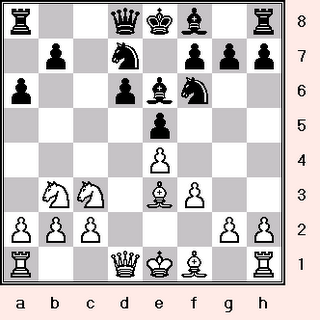
What's the game plan for White?

White intends to acquire and dominate the
vulnerable d5 square (Qd1-d2, O-O-O,
followed by a timely Nc3-d5). To augment
that objective, he also aims to destabilize
the f6 knight and subsequently eliminate its
d5 influence (g2-g4-g5/h2-h4/Rh1-g1). Finally,
he wants to avail himself of the c5 square
(Qd2-f2/Nb3-c5/Be3-c5), thanks to a more than
likely Rd1-Qd8 x-ray, which prevents ... dxc5.
What's the game plan for Black?

Black means to attack White on the queenside
by way of b7-b5-b4/Nb-d7-b6-c4/Ra8-(b8)
-c8/Qd8-c7/a6-a5-a4. With regards to King
safety, he aims to castle into the storm,
on the strength of the defensive maneuvers
... Nf6-h5, ... f7-f5, and ... Nh5-f6. Lastly,
he intends to minimize White's control of d5
and execute a ... d6-d5 break, if and when the
opportunity arises.
Also available:
Chess: Understanding the Sicilian Defense
(Najdorf Variation) Part I
http://chesscoach1950.blogspot.com/2006/01/chess-understanding-sicilian-defense.html
Chess: Understanding the Sicilian Najdorf Part II
http://chesscoach1950.blogspot.com/2006/07/chess-understanding-sicili_115316520058364198.html
Chess: Understanding the Sicilian Najdorf Part III
http://chesscoach1950.blogspot.com/2006/07/chess-understanding-sicilian-najdorf.html
Chess: Understanding the Sicilian Najdorf Part IV
http://chesscoach1950.blogspot.com/2006/07/chess-understanding-sicilian-najdorf_17.html
Chess: Understanding the Sicilian Defense
(Accelerated Fianchetto)
http://chesscoach1950.blogspot.com/2006/07/chess-understanding-sicilian-defense.html
Chess: Understanding the Sicilian Dragon
http://chesscoach1950.blogspot.com/2006/01/chess-understanding-sicilian-dragon.html
Chess: Understanding the Sicilian Defense
(Löwenthal Variation)
http://chesscoach1950.blogspot.com/2006/08/chess-understanding-sicilian-defense_23.html
Chess: Understanding the Sicilian Defense
http://chesscoach1950.blogspot.com/2006/08/chess-understanding-sicilian-defense_22.html
Understanding the Sicilian Defense (Sozin Variation)
http://chesscoach1950.blogspot.com/2006/01/chess-understanding-sicilian-defense_30.html
Understanding the Sicilian Defense
(Sveshnikov Variation)
http://chesscoach1950.blogspot.com/2006/06/chess-understanding-sicilian-defense.html
Understanding the Sicilian Richter-Rauzer
http://chesscoach1950.blogspot.com/2006/06/chess-understanding-sicilian-richter.html
Understanding the Smith Morra Gambit
http://chesscoach1950.blogspot.com/2006/06/chess-understanding-smith-morra-gambit.html
Chess: Understanding the Sicilian Defense
(Keres Attack) Part I
http://chesscoach1950.blogspot.com/2006/06/chess-understanding-sicilian.html
Sample Variation
For explanations of moves 1 through 5 please refer to:
Chess: Understanding the Sicilian Defense
(Najdorf Variation) Part I
http://chesscoach1950.blogspot.com/2006/01/chess-understanding-sicilian-defense.html
1 e4 c5 2 Nf3 d6 3 d4 cxd4 4 Nxd4 Nf6 5 Nc3 a6
6 Be3
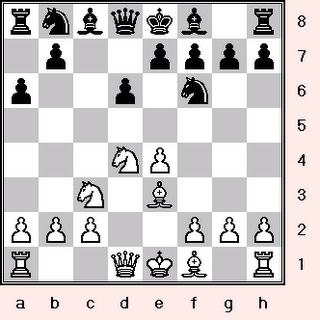
Currently the bee's knees.
(i) Reinforces d4 and protects f2.
(ii) Signals White's intent to castle
long and storm Black's kingside.
For the more charged 6 Bg5, please refer to:
Understanding the Sicilian Defense
(Najdorf Variation) Part I
6 ... e5
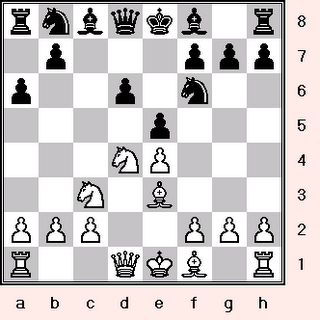
(i) Threatening 7 ... exd4.
(ii) Counterattacking f4.
(iii) Enabling Bf8-e7 and Bc8-e6.
(iv) Eliminating the possibility of e4-e5.
Not too long ago, this central assertion was considered
taboo because of the gaping hole it creates on d5.
However, modern day analysis has revealed possibilities
for active play that offset d5.
Another favored alternative is to question
the bishop's e3 presence through 6 ... Ng4.
For instance, 6 ... Ng4 7 Bg5 (7 Bc1) 7 ... h6 8 Bh4
8 ... g5 9 Bg3 Bg7, P. Svidler-A. Grischuk,
Monte Carlo MNS 2006.
6 ... e6 transposes to a Scheveningen game as
sampled in Understanding the Sicilian Defense
(Keres Attack) Part I
7 Nb3

Evading capture, and, keeping an eye on a5,
especially since the Black Queen is enamored
of that square. Furthermore, the e3 bishop
gets an opportunity to flex its muscle along
the g1-a7 diagonal, and the Queen is given
access to the half open d-file.
7 Nf3 is also a solid possibility: 7 ... Qc7 8 a4 Be7
9 a5 O-O 10 Be2 Nbd7 11 O-O b5 12 axb6 Nxb6. Or,
7 Nf3 Be7 8 Bc4 O-O 9 O-O Be6 10 Bb3 Nc6,
P. Svidler-P. Leko, Linares 2006.
7 Nf5 is inadvisable because it allows the
liberating 7 ... d5! 8 Bg5 e4 9 Bxf6 gxf6 10 Ne2.
7 ... Be6
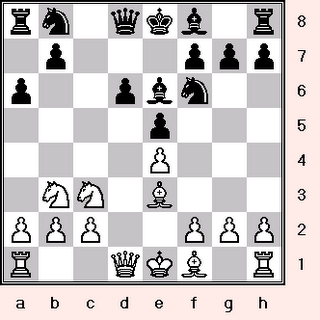
(i) Mitigating White's control of d5, in conjunction
with the f6 knight; Black is also hoping for a timely
d6-d5 so as to cover up the hole.
(ii) Initiating a prompt mobilization of the queenside.
Since White has intimated castling long, Black prepares
to attack that wing. The bishop awaits the White monarch
by assuming control of the a2-g8 diagonal. Other viable
options are:
7 ... Be7 8 Be2 Be6 9 O-O O-O 10 Qd2 Nbd7 11 a4 Rc8
12 a5 Qc7 13 Rfd1.
7 ... Nbd7 and 7 ... Qc7.
7 ... Ng4 is bad because it does nothing to help Black
in the fight for d5. Actually, it enables White to
effortlessly acquire that focal point.
For instance, 8 Nd5 Nxe3 9 Nxe3 Be7 10 Bc4.
8 f3
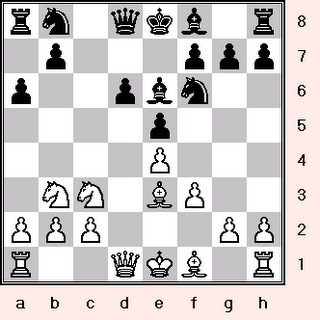
(i) Setting up for White's kingside storm (g2-g4/h2-h4).
(ii) Buttressing e4.
8 ... Nbd7

Further development of the queenside.
Once Black initiates his attack via
the b7-b5 break, the knight can join
the fray by relocating to c4 (Nbd7-b6-c4).
8 ... Be7 9 Qd2 O-O 10 O-O-O Nbd7 11 g4 Qc7
12 Kb1 Rfc8 13 g5 Nh5.
8 ... h5 9 Qd2 Nbd7 10 O-O-O Rc8 11 Kb1 Be7
12 Nd5 Nxd5 13 exd5 Bf5 14 Bd3 Bxd3 15 Qxd3.
8 ... Nc6 9 Nd5 Bxd5 10 exd5 Ne7 11 c4 g6
12 Bd3 Bg7 13 O-O O-O 14 Nd2.
8 ... b5 9 a4 b4 10 Nd5 Bxd5 11 exd5 Nbd7
12 a5 Qc7 13 Qd2 Qb7 14 Bc4 Be7 15 Ra4 Rb8
16 O-O.
8 ... d5 9 exd5 Nxd5 10 Nxd5 Bxd5 11 c4 Bb4+
12 Kf2 Be6 13 Qxd8+ Kxd8 14 Rd1+.
9 Qd2
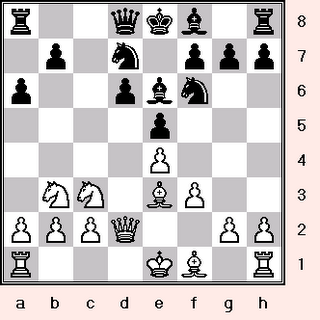
Making way for queenside castling, which, in turn,
enables the Queen and a1-rook to team up on the
half open d-file and frustrate Black's ambitions
of pushing d6-d5. An immediate 9 g4
is also a possibility: 9 g4 b5 10 g5 b4 11 Ne2 Nh5
12 Qd2 a5.
9 Nd5!? Nxd5 10 exd5 Bf5.
9 Nd5!? Bxd5 10 exd5 Be7.
9 ... Be7
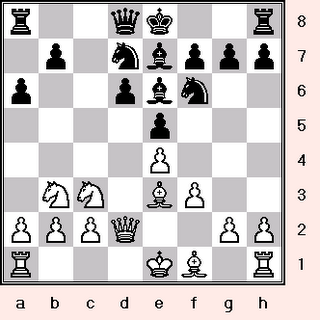
Sensibly developing another piece and reserving
the right to castle. 9 ... b5; 9 ... h5;
9 ... Rc8; 9 ... Qc7; 9 ... Nb6; 9 ... h6;
9 ... Nc5.
10 g4
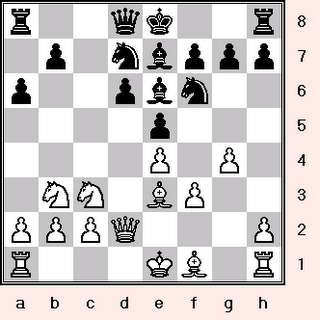
And the attack begins.
10 O-O-O O-O 11 g4 Qc7 12 Kb1 Rfc8 13 g5 Nh5
14 Nd5 Bxd5 15 exd5 .
10 Nd5 Nxd5 11 exd5 Bf5.
10 ... h6

But Black will not yield to an unchallenged g4-g5!
(10 ... 0-0, 10 ... Rc8, 10 ... Qc7, 10 ... Nb6, 10 ... b5)
11 O-O-O
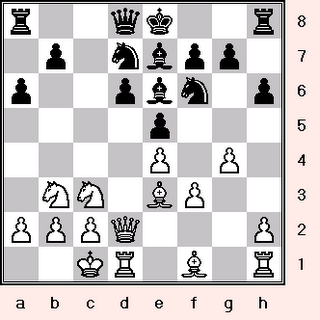
11 h4 b5 12 O-O-O Nb6 13 Qf2 Nfd7 14 Kb1 Qc7
15 Nd5 Bxd5 16 exd5 Nc4 17 Bc1.
11 Nd5 Bxd5 12 exd5.
11 Rg1 b5 12 O-O-O Nb6 13 Qf2 Nfd7 14 Kb1.
11 ... b5

11 ... O-O? 12 h4.
12 Kb1
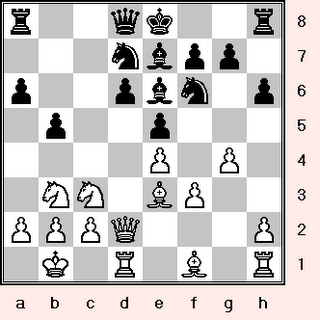
After castling long against the Sicilian,
it is always a good idea to remove the King
from the c1-h6 diagonal, otherwise Black is
more than likely to get a complimentary
check along that avenue. Also, the King
is better off away from the half open
c-file, because it's Black's main route
of attack.
12 h4 Nb6 13 Qf2 Nfd7 14 Kb1 Qc7 15 Nd5 Bxd5
16 exd5 Nc4 17 Bc1.
12 Nd5 Bxd5 13 exd5 Nb6 14 Bxb6 Qxb6.
12 ... Nb6
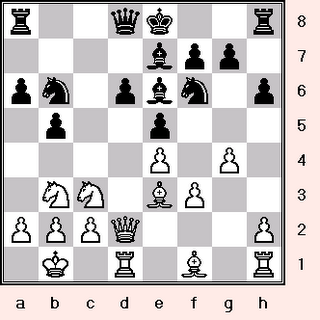
12 ... Qc7 13 h4 b4 14 Nd5 Bxd5 15 exd5 Nb6
16 Qxb4 Nfxd5 17 Rxd5 Nxd5 18 Qe4 Nxe3
19 Qxa8+ Bd8.
13 Qf2

(i) Attacking the b6 knight a second time.
(ii) Allowing the d1 rook to keep an eye on
the enemy Queen. White can now use the
c5 square as a stepping stone into enemy
territory because should Black capture dxc5,
Rxd8 wins the Queen.
(iii) Relocating to the kingside in order
to augment the pawn demonstration.
Nothing beats a multipurpose move!
13 h4 b4 14 Bxb6 Qxb6 15 Nd5 Bxd5 16 exd5 a5.
13 Na5 Qc7 14 Bxb6 Qxb615 Nd5 Nxd5 16 exd5
16 ... Bd7 17 h4 b4 18 Nc6 Bxc6 19 dxc6 Rc8.
13 Bxb6 Qxb6 14 h4 b4 15 Nd5 Bxd5 16 exd5 a5.
13 ... Rb8
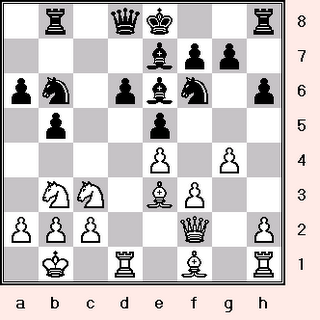
Protecting the b6 knight from 14 Bxb6 and scoping
out the White King along b8-b1. Even though there
are several pieces between the rook and King, the
mere possibility of contact makes it worthwhile
for Black to monitor the b-file.
13 ... Nfd7 14 h4 Qc7 15 Nd5 Bxd5 16 exd5 Nc4
17 Bc1.
13 ... Nc4 14 Bxc4 bxc4 15 Nc5 Qc7 16 N5a4 Rb8
17 Nb6 Bd8 18 Nbd5 Qb7.
14 Nc5
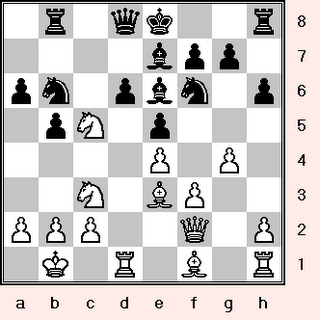
14 h4.
14 ... b4
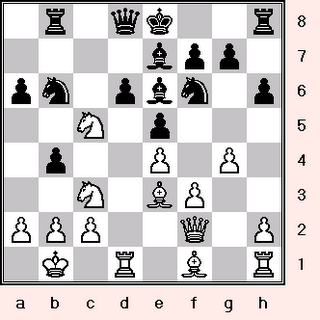
14 ... Bc8 15 Nd3 Nc4 16 Nb4 Nxe3 17 Qxe3 Qb6
18 Qxb6 Rxb6 19 Be2 Bb7.
15 Ne2
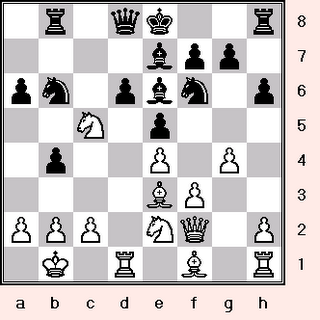
15 N3a4, 15 Nxa6, 15 Nxe6.
15 ... Nc4

16 Nxe6 fxe6
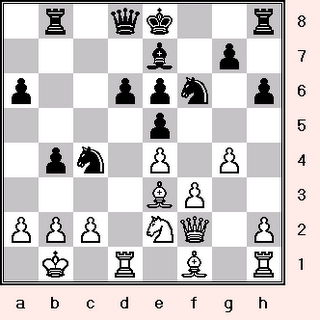
17 Ng3 Qc7
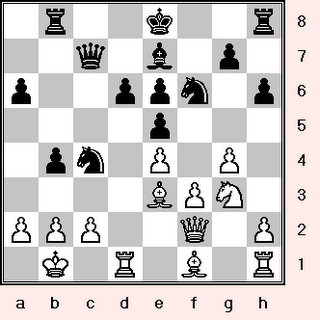
17 Nc1/17 ... Nxe3.
18 h4
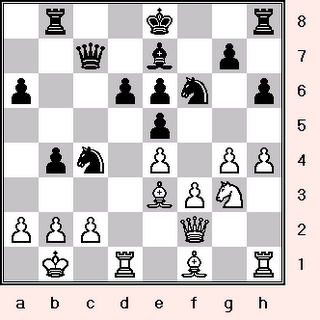
18 ... a5 19 Bxc4 Qxc4.
By ChessCoach@care2.com
6 Be3 e5 7 Nb3 Be6 8 f3 Nbd7 Line (English Attack)

What's the game plan for White?

White intends to acquire and dominate the
vulnerable d5 square (Qd1-d2, O-O-O,
followed by a timely Nc3-d5). To augment
that objective, he also aims to destabilize
the f6 knight and subsequently eliminate its
d5 influence (g2-g4-g5/h2-h4/Rh1-g1). Finally,
he wants to avail himself of the c5 square
(Qd2-f2/Nb3-c5/Be3-c5), thanks to a more than
likely Rd1-Qd8 x-ray, which prevents ... dxc5.
What's the game plan for Black?

Black means to attack White on the queenside
by way of b7-b5-b4/Nb-d7-b6-c4/Ra8-(b8)
-c8/Qd8-c7/a6-a5-a4. With regards to King
safety, he aims to castle into the storm,
on the strength of the defensive maneuvers
... Nf6-h5, ... f7-f5, and ... Nh5-f6. Lastly,
he intends to minimize White's control of d5
and execute a ... d6-d5 break, if and when the
opportunity arises.
Also available:
Chess: Understanding the Sicilian Defense
(Najdorf Variation) Part I
http://chesscoach1950.blogspot.com/2006/01/chess-understanding-sicilian-defense.html
Chess: Understanding the Sicilian Najdorf Part II
http://chesscoach1950.blogspot.com/2006/07/chess-understanding-sicili_115316520058364198.html
Chess: Understanding the Sicilian Najdorf Part III
http://chesscoach1950.blogspot.com/2006/07/chess-understanding-sicilian-najdorf.html
Chess: Understanding the Sicilian Najdorf Part IV
http://chesscoach1950.blogspot.com/2006/07/chess-understanding-sicilian-najdorf_17.html
Chess: Understanding the Sicilian Defense
(Accelerated Fianchetto)
http://chesscoach1950.blogspot.com/2006/07/chess-understanding-sicilian-defense.html
Chess: Understanding the Sicilian Dragon
http://chesscoach1950.blogspot.com/2006/01/chess-understanding-sicilian-dragon.html
Chess: Understanding the Sicilian Defense
(Löwenthal Variation)
http://chesscoach1950.blogspot.com/2006/08/chess-understanding-sicilian-defense_23.html
Chess: Understanding the Sicilian Defense
http://chesscoach1950.blogspot.com/2006/08/chess-understanding-sicilian-defense_22.html
Understanding the Sicilian Defense (Sozin Variation)
http://chesscoach1950.blogspot.com/2006/01/chess-understanding-sicilian-defense_30.html
Understanding the Sicilian Defense
(Sveshnikov Variation)
http://chesscoach1950.blogspot.com/2006/06/chess-understanding-sicilian-defense.html
Understanding the Sicilian Richter-Rauzer
http://chesscoach1950.blogspot.com/2006/06/chess-understanding-sicilian-richter.html
Understanding the Smith Morra Gambit
http://chesscoach1950.blogspot.com/2006/06/chess-understanding-smith-morra-gambit.html
Chess: Understanding the Sicilian Defense
(Keres Attack) Part I
http://chesscoach1950.blogspot.com/2006/06/chess-understanding-sicilian.html
Sample Variation
For explanations of moves 1 through 5 please refer to:
Chess: Understanding the Sicilian Defense
(Najdorf Variation) Part I
http://chesscoach1950.blogspot.com/2006/01/chess-understanding-sicilian-defense.html
1 e4 c5 2 Nf3 d6 3 d4 cxd4 4 Nxd4 Nf6 5 Nc3 a6
6 Be3

Currently the bee's knees.
(i) Reinforces d4 and protects f2.
(ii) Signals White's intent to castle
long and storm Black's kingside.
For the more charged 6 Bg5, please refer to:
Understanding the Sicilian Defense
(Najdorf Variation) Part I
6 ... e5

(i) Threatening 7 ... exd4.
(ii) Counterattacking f4.
(iii) Enabling Bf8-e7 and Bc8-e6.
(iv) Eliminating the possibility of e4-e5.
Not too long ago, this central assertion was considered
taboo because of the gaping hole it creates on d5.
However, modern day analysis has revealed possibilities
for active play that offset d5.
Another favored alternative is to question
the bishop's e3 presence through 6 ... Ng4.
For instance, 6 ... Ng4 7 Bg5 (7 Bc1) 7 ... h6 8 Bh4
8 ... g5 9 Bg3 Bg7, P. Svidler-A. Grischuk,
Monte Carlo MNS 2006.
6 ... e6 transposes to a Scheveningen game as
sampled in Understanding the Sicilian Defense
(Keres Attack) Part I
7 Nb3

Evading capture, and, keeping an eye on a5,
especially since the Black Queen is enamored
of that square. Furthermore, the e3 bishop
gets an opportunity to flex its muscle along
the g1-a7 diagonal, and the Queen is given
access to the half open d-file.
7 Nf3 is also a solid possibility: 7 ... Qc7 8 a4 Be7
9 a5 O-O 10 Be2 Nbd7 11 O-O b5 12 axb6 Nxb6. Or,
7 Nf3 Be7 8 Bc4 O-O 9 O-O Be6 10 Bb3 Nc6,
P. Svidler-P. Leko, Linares 2006.
7 Nf5 is inadvisable because it allows the
liberating 7 ... d5! 8 Bg5 e4 9 Bxf6 gxf6 10 Ne2.
7 ... Be6

(i) Mitigating White's control of d5, in conjunction
with the f6 knight; Black is also hoping for a timely
d6-d5 so as to cover up the hole.
(ii) Initiating a prompt mobilization of the queenside.
Since White has intimated castling long, Black prepares
to attack that wing. The bishop awaits the White monarch
by assuming control of the a2-g8 diagonal. Other viable
options are:
7 ... Be7 8 Be2 Be6 9 O-O O-O 10 Qd2 Nbd7 11 a4 Rc8
12 a5 Qc7 13 Rfd1.
7 ... Nbd7 and 7 ... Qc7.
7 ... Ng4 is bad because it does nothing to help Black
in the fight for d5. Actually, it enables White to
effortlessly acquire that focal point.
For instance, 8 Nd5 Nxe3 9 Nxe3 Be7 10 Bc4.
8 f3

(i) Setting up for White's kingside storm (g2-g4/h2-h4).
(ii) Buttressing e4.
8 ... Nbd7

Further development of the queenside.
Once Black initiates his attack via
the b7-b5 break, the knight can join
the fray by relocating to c4 (Nbd7-b6-c4).
8 ... Be7 9 Qd2 O-O 10 O-O-O Nbd7 11 g4 Qc7
12 Kb1 Rfc8 13 g5 Nh5.
8 ... h5 9 Qd2 Nbd7 10 O-O-O Rc8 11 Kb1 Be7
12 Nd5 Nxd5 13 exd5 Bf5 14 Bd3 Bxd3 15 Qxd3.
8 ... Nc6 9 Nd5 Bxd5 10 exd5 Ne7 11 c4 g6
12 Bd3 Bg7 13 O-O O-O 14 Nd2.
8 ... b5 9 a4 b4 10 Nd5 Bxd5 11 exd5 Nbd7
12 a5 Qc7 13 Qd2 Qb7 14 Bc4 Be7 15 Ra4 Rb8
16 O-O.
8 ... d5 9 exd5 Nxd5 10 Nxd5 Bxd5 11 c4 Bb4+
12 Kf2 Be6 13 Qxd8+ Kxd8 14 Rd1+.
9 Qd2

Making way for queenside castling, which, in turn,
enables the Queen and a1-rook to team up on the
half open d-file and frustrate Black's ambitions
of pushing d6-d5. An immediate 9 g4
is also a possibility: 9 g4 b5 10 g5 b4 11 Ne2 Nh5
12 Qd2 a5.
9 Nd5!? Nxd5 10 exd5 Bf5.
9 Nd5!? Bxd5 10 exd5 Be7.
9 ... Be7

Sensibly developing another piece and reserving
the right to castle. 9 ... b5; 9 ... h5;
9 ... Rc8; 9 ... Qc7; 9 ... Nb6; 9 ... h6;
9 ... Nc5.
10 g4

And the attack begins.
10 O-O-O O-O 11 g4 Qc7 12 Kb1 Rfc8 13 g5 Nh5
14 Nd5 Bxd5 15 exd5 .
10 Nd5 Nxd5 11 exd5 Bf5.
10 ... h6

But Black will not yield to an unchallenged g4-g5!
(10 ... 0-0, 10 ... Rc8, 10 ... Qc7, 10 ... Nb6, 10 ... b5)
11 O-O-O

11 h4 b5 12 O-O-O Nb6 13 Qf2 Nfd7 14 Kb1 Qc7
15 Nd5 Bxd5 16 exd5 Nc4 17 Bc1.
11 Nd5 Bxd5 12 exd5.
11 Rg1 b5 12 O-O-O Nb6 13 Qf2 Nfd7 14 Kb1.
11 ... b5

11 ... O-O? 12 h4.
12 Kb1

After castling long against the Sicilian,
it is always a good idea to remove the King
from the c1-h6 diagonal, otherwise Black is
more than likely to get a complimentary
check along that avenue. Also, the King
is better off away from the half open
c-file, because it's Black's main route
of attack.
12 h4 Nb6 13 Qf2 Nfd7 14 Kb1 Qc7 15 Nd5 Bxd5
16 exd5 Nc4 17 Bc1.
12 Nd5 Bxd5 13 exd5 Nb6 14 Bxb6 Qxb6.
12 ... Nb6

12 ... Qc7 13 h4 b4 14 Nd5 Bxd5 15 exd5 Nb6
16 Qxb4 Nfxd5 17 Rxd5 Nxd5 18 Qe4 Nxe3
19 Qxa8+ Bd8.
13 Qf2

(i) Attacking the b6 knight a second time.
(ii) Allowing the d1 rook to keep an eye on
the enemy Queen. White can now use the
c5 square as a stepping stone into enemy
territory because should Black capture dxc5,
Rxd8 wins the Queen.
(iii) Relocating to the kingside in order
to augment the pawn demonstration.
Nothing beats a multipurpose move!
13 h4 b4 14 Bxb6 Qxb6 15 Nd5 Bxd5 16 exd5 a5.
13 Na5 Qc7 14 Bxb6 Qxb615 Nd5 Nxd5 16 exd5
16 ... Bd7 17 h4 b4 18 Nc6 Bxc6 19 dxc6 Rc8.
13 Bxb6 Qxb6 14 h4 b4 15 Nd5 Bxd5 16 exd5 a5.
13 ... Rb8

Protecting the b6 knight from 14 Bxb6 and scoping
out the White King along b8-b1. Even though there
are several pieces between the rook and King, the
mere possibility of contact makes it worthwhile
for Black to monitor the b-file.
13 ... Nfd7 14 h4 Qc7 15 Nd5 Bxd5 16 exd5 Nc4
17 Bc1.
13 ... Nc4 14 Bxc4 bxc4 15 Nc5 Qc7 16 N5a4 Rb8
17 Nb6 Bd8 18 Nbd5 Qb7.
14 Nc5

14 h4.
14 ... b4

14 ... Bc8 15 Nd3 Nc4 16 Nb4 Nxe3 17 Qxe3 Qb6
18 Qxb6 Rxb6 19 Be2 Bb7.
15 Ne2

15 N3a4, 15 Nxa6, 15 Nxe6.
15 ... Nc4

16 Nxe6 fxe6

17 Ng3 Qc7

17 Nc1/17 ... Nxe3.
18 h4

18 ... a5 19 Bxc4 Qxc4.
By ChessCoach@care2.com
2 Comments:
First of all, I want to thank you for exposing these openings secrtes. In my opinion, they are the best ones I've found on the internet. I'm a beginner who's trying to learn more about the game and I was wondering if you could help me with some free chess books, CDs or DVDs?
These resources are hard to come by here in Severin, an especially small town in Romania. Thank you for your time.
L.Balcescu
Thank you for getting in touch.
I'm glad to hear the blog is of help to you. Please feel free to email me requests for openings you would like to learn about. I'm more than happy to write articles on them for you. I understand how chess resources can be difficult to come by, and that's why I have this blog going.
I wish I could do more for you, but presently I can only offer you the aforementioned online assistance. So, please, do drop me an email should you require information on a particular opening. I'll definitely give it my best shot.
Best regards,
ChessCoach
ChessCoach@care2.com
Post a Comment
<< Home